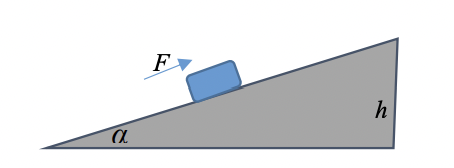A block is pushed at constant speed up along a ramp through the length, d, of the ramp. The direction of the push force, F, is up along the ramp. Assume mass of the block is m, the inclination of ramp is α, and friction coefficient is μk. (a) Draw free body diagram of the block showing all forces acting on it. Choose one axis along the plane. Use the equilibrium conditions to prove that the push force F = μk mg cosα + mg sinα (b) Write down the generic formula for work done. Use it to find out the work done by F when block moves up through d. Recall, you draw F - d diagram to decide the angle used in the generic work formula. Is the work done positive, negative, or zero? (c) Find the work done by x and y components of wight mg (i.e. gravitational force) in terms of m, g and α etc when block moves up through d. The components should be known from your work in part a.
A block is pushed at constant speed up along a ramp through the length, d, of the ramp. The direction of the push force, F, is up along the ramp. Assume mass of the block is m, the inclination of ramp is α, and friction coefficient is μk.
(a) Draw free body diagram of the block showing
all forces acting on it. Choose one axis along the plane. Use the equilibrium conditions to prove that the push force F = μk mg cosα + mg sinα
(b) Write down the generic formula for work done. Use it to find out the work done by F when block
moves up through d. Recall, you draw F - d diagram to decide the angle used in the generic work formula. Is the
work done positive, negative, or zero?
(c) Find the work done by x and y components of wight mg (i.e. gravitational force) in terms of m, g and α etc when block moves up through d. The components should be known from your work in part a.
(d) Find the friction force using fk = μk n; and find the work done by it force in terms of m, g and α etc
when block slides through d. Is it positive, negative, or zero?
(e) Find the work done by the normal force when block slides through d. Is it positive, negative, or zero?
(f) Add together the work done by F, components of weight, friction and normal forces found in part b, c, d, and e. Simplify the expression as much as you can. Is the sum zero? (Note: it should be zero as it is the net work done by forces acting on the object moving with constant velocity)

Trending now
This is a popular solution!
Step by step
Solved in 5 steps with 1 images









